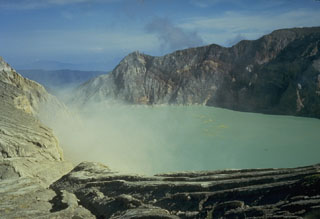Report on Ijen (Indonesia) — August 1997
Bulletin of the Global Volcanism Network, vol. 22, no. 8 (August 1997)
Managing Editor: Richard Wunderman.
Ijen (Indonesia) Elevated seismicity during 27 June-11 July; lake-color shifts and odors
Please cite this report as:
Global Volcanism Program, 1997. Report on Ijen (Indonesia) (Wunderman, R., ed.). Bulletin of the Global Volcanism Network, 22:8. Smithsonian Institution. https://doi.org/10.5479/si.GVP.BGVN199708-263350
Ijen
Indonesia
8.058°S, 114.242°E; summit elev. 2769 m
All times are local (unless otherwise noted)
The Volcanological Survey of Indonesia (VSI) reported that seismic activity had been on the rise since about 27 June and that the color of the water in Kawah Ijen crater lake had changed (BGVN 22:06). A visiting geologist had also noted lake bubbling and upwelling. The following report provides additional information about the activity during late June-July.
Seismicity remained high during 27 June through about 11 July 1997 (figure 2). This increase, however, was not followed by phreatic eruptions as in 1993 (BGVN 18:07 and 19:05). Still, seismic data indicated that the number of deep A-type and especially shallow B-type volcanic earthquakes sharply increased. The maximum amplitude of volcanic tremor also increased rapidly.
 |
Figure 2. Seismicity at Kawah Ijen: daily number of volcanic earthquakes (top) and maximum amplitudes of volcanic tremor (bottom), June-July 1997. Courtesy of Isya N. Dana, Jr., VSI. |
The color of the crater lake changed from light green to whitish (pale) green and a very strong sulfuric odor was noted at the side of the crater lake. However, these changes were not followed by corresponding shifts in the lake's water temperature (figure 3). Because of the increasing activity, VSI warned residents, tourists, and sulfur miners that the crater area was closed until early August 1997.
 |
Figure 3. Crater-lake water temperatures measured at Kawah Ijen, January-August 1997. Courtesy of Isya N. Dana, Jr., VSI. |
Ijen Caldera encloses a group of small stratovolcanoes. The active crater at Kawah Ijen is ~700 m across and 200 m deep. Kawah Ijen's noteworthy features include a mineral-rich acid lake and fumarolic sulfur in sufficient abundance to support active mining (see photos in Krafft and Krafft, 1979).
Reference. Krafft, K,. and Krafft, M., 1979, Volcanoes: Earth's Awakening (originally published in French under the title "Volcans"): Hachette/Hammond Inc., ISBN 0-8437-3760-3, plates on p. 142, 156, and 157.
Geological Summary. The Ijen volcano complex at the eastern end of Java consists of a group of small stratovolcanoes constructed within the 20-km-wide Ijen (Kendeng) caldera. The north caldera wall forms a prominent arcuate ridge, but elsewhere the rim was buried by post-caldera volcanoes, including Gunung Merapi, which forms the high point of the complex. Immediately west of the Gunung Merapi stratovolcano is the historically active Kawah Ijen crater, which contains a nearly 1-km-wide, turquoise-colored, acid lake. Kawah Ijen is the site of a labor-intensive mining operation in which baskets of sulfur are hand-carried from the crater floor. Many other post-caldera cones and craters are located within the caldera or along its rim. The largest concentration of cones forms an E-W zone across the southern side of the caldera. Coffee plantations cover much of the caldera floor; nearby waterfalls and hot springs are tourist destinations.
Information Contacts: Isya N. Dana, Jr., Volcanological Survey of Indonesia (VSI), Jalan Diponegoro 57, Bandung 40122, Indonesia.

